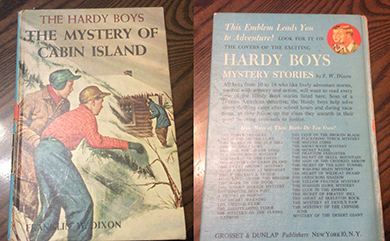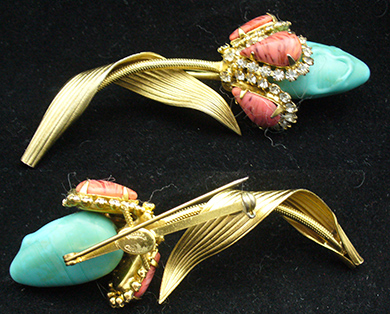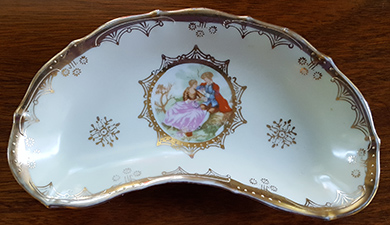 |
|
|||
 |
 |
|||
RINKER ON COLLECTIBLES — Column #1665 Copyright © Harry Rinker, LLC 2018 Questions
and Answers
QUESTION: Several years ago at a yard sale, I purchased a copy of “The Hardy Boys: The Mystery of Cabin Island” with its dust jacket. The copyright information read: “Copyright 1929, by / GROSSETT & DUNLAP, INC. / All Rights Reserved / The Hardy Boys: The Mystery of Cabin Island.” The dust jacket pictures the Hardy Boys wearing winter clothing and looking to their right at a snow-covered cottage into which a man is entering. The back of the dust jacket contains a list of 40 Hardy Boy titles. When I listed it on eBay, a very rude potential buyer emailed to tell me my description was fraudulent and that the book dated from the 1960s and not 1929. I was embarrassed. What is your opinion? – DL, Email Question 
ANSWER: There is little to no tolerance or understanding among eBay buyers who feel they are preordained by a higher power to correct injustices when they encounter them. Rather than using the moment to educate and explain why your listing was wrong, the eBay buyer made the immediate and false assumption that you deliberately tried to pass off a later edition of the title for a first edition. These individuals are under the impression that they never make mistakes. You did make a mistake, albeit an honest one. Although your copy of “The Hardy Boys: The Mystery of Cabin Island” is copyrighted 1929, it is not a first edition. It indeed was printed in the 1960s. Edward Stratemeyer of the Stratemeyer Syndicate conceived the idea for a Hardy Boys series in 1926. He developed outlines for several stories and hired ghostwriters to write them. Leslie-McFarlane wrote volumes 1-16 and 22-24. “The Hardy Boys: The Mystery of Cabin Island” is Volume 8 in the series. In 1959, the Stratemeyer Syndicate began a project to update the first 38 titles in the series. The stories were reduced in length, had updated prose, and removed racial stereotypes. The cover art also was changed. The cover art is the first of two obvious clues that indicate your edition dates from the 1960s. The 1929 cover art was done by W. S. Rogers. In 1944, A. O. Scot provided artwork for an updated cover. Rudy Nappi did the artwork for the third cover in 1960. The website www.hardyboys.us contains a detailed description of each title in the series as well as illustrations of the different cover art used for each title. Had you researched your book before listing it, you would have properly dated your book. The second and most obvious clue was the back of the dust jacket. If you had a copy of the 1929 first edition, the list of titles on the back would only have included the seven that proceeded “The Hardy Boys: The Mystery of Cabin Island.” The fact that 40 titles were listed should have set off an “alarm bell” in your head. I did not see your eBay listing. Assuming you pictured the cover and had a low opening starting bid, any serious collector would have known you were not listing a first edition. In a caveat emptor (let the buyer beware) environment, potential bidders are responsible to do their homework and make certain they knew upon what they are bidding. When teaching collectors and dealers about antiques and collectibles, I ask them: “what do we call the mistakes we make?” The answer is tuition. Your experience is a learning moment for everyone involved in the trade. QUESTION: My husband and I own an electric lamp that came from my husband’s great aunt. He is 86 and remembers it hanging above the mantel when he was a young boy. The lamp has a filigree metal base with an orange bellflower vase-like shade in the center. Three “C” shaped stems radiate out from the standard, each with an orange bellflower shade. The base has a hole in it. What information can you provide about the lamp? – Mrs. T Grim, Richmond, OH ANSWER: While the lamp may have hung from a wall above a mantel, it most likely did not hang from a ceiling. The photographs that accompanied your letter suggest the orange glass shades were not as securely set in their mounts as they should be for a ceiling lamp. At first, I thought the hole was for an electrical wire, a possibility if the lamp also could serve as a table lamp as it does now. More likely, an on-off switch once filled the hole. Assuming the lamp is period, it dates from the first or second decade of the 20th century. Check to see if the shades are marked. Kew Blas or Quezal are two possibilities. Tiffany most definitely is not. My guess is that they are not. Ceiling lights are classified as architectural salvage, meaning that if you are selling them, you get very little, but, if you buy them, you pay a “pretty penny.” The plus for your lamp is that it converts easily to a functional table top lamp. The base and orange shades elevate it to the level of a conversation piece. The lamp's conversational value is between $100.00 and $125.00. Its reuse decorative value is slightly higher. QUESTION: I own a Hattie Carnegie floral pin. It features a leaf wrapping around a stem that holds a turquoise flower bud beneath which are three red ovals surrounded by rhinestones. What is its history and how much is it worth? – PH, Reading, PA 
ANSWER: Born Henrietta Kanengeiser in Austria, she immigrated to the United States with her family around 1900. She adopted “Carnegie” as her last name in the 1920s. While working as a salesperson at Macy’s, she became familiar with women’s fashions. Her work in the Hat Department resulted in the nickname “Hattie.” Hattie Carnegie opened her first shop in 1909. Hattie Carnegie, Inc., was organized in 1918. She created a head-to-toe look complete with accessories such as hats and jewelry. Her official line of marked jewelry did not appear until 1930. Carnegie flourished during the “cocktail jewelry” era. Hollywood stars flocked to her studios. Her jewelry designs were wild, thus adding flair to basic outfits. Carnegie hired skilled jewelry designers such as Nadine Effront, Kenneth Jay Lane, and Norman Norell. Avoiding paste, Carnegie’s pieces often featured enamels, gilt metals, and/or plastic. Pieces were inspired by Asian and Indian motifs. Ethnic human heads and animals were popular. Lucite was used into the 1950s. Hattie Carnegie died in 1956. Her firm continued to produce jewelry long after her death. The most common mark is a script “Hattie Carnegie” enclosed in a cartouche. Pieces marked “HC” on a diamond in an oval frame are more sought after. Pieces with “Hattie Carnegie” in an oval tag date from the 1970s. Your piece dates from the 1970s or later. Although it has some interest to collectors, most individuals will buy it to wear. Based on comparable pieces I found on WorthPoint.com, the secondary market retail value of your pin is between $35.00 and $45.00. QUESTION: I have a demi-lune porcelain dish that I wish to sell on eBay. I do not remember where I got it or how much I paid for it. The front features a gold transfer border and a center medallion featuring a courting couple in Colonial era dress. The back is marked with a dot above a Beehive beneath which is “K.C/1028.” Any information you can provide will be most helpful. – PG, Chicago, IL, Email Question 
ANSWER: Since no dimensions were included in your email or as captions to your images, I am assuming you own a bone dish, a dinnerware accessory designed to hold discarded bones from fish and placed to the left of the dinner plate when fish was served. Most bone dishes were crescent shaped to curve around the plate. Bone dishes were made in sets and popular tabletop accessories from the 1880s through the 1920s. The beehive mark on the back of your bone dish indicated it was made in Vienna, home to dozens of pottery and porcelain manufacturers. The use of a decal border and center medallion suggests a lesser quality, inexpensive piece. The motif suggests an early 20th century origin. Bone dish collectors are scarce. At a flea market, the standard asking price for a bone dish is less than $5.00. At a garage sale, bone dishes are fifty cent (at best) offerings. Given this, my advice is not to list the bone dish for sale on eBay. Elaborate Victorian era dinnerware services could include a crescent shaped salad dish. These salad dishes measure six-inches or longer. Bone dishes are much smaller. Harry L. Rinker welcomes questions from readers about
collectibles, those mass-produced items from the twentieth and twenty-first centuries.
Selected letters will be answered in this column.
Harry cannot provide personal answers.
Photos and other material submitted cannot be
returned.
Send your questions to: Rinker on Collectibles, 5955 Mill
Point Court SE, Kentwood, MI 49512.
You also can e-mail your questions to
harrylrinker@aol.com.
Only e-mails containing a full name and mailing address
will be considered.
You can listen
and participate in
WHATCHA GOT?, Harry’s
antiques and collectibles radio call-in show, on Sunday mornings between 8:00 AM
and 10:00 AM Eastern Time.
If you
cannot find it on a station in your area,
WHATCHA GOT?
streams live on the Internet at www.gcnlive.com.
|
||||